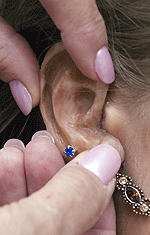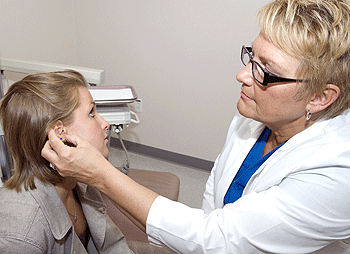Like any 17-year-old, Emily Gravenhorst follows a routine to get ready for a day of high school. She showers, styles her hair, puts on her makeup and eats breakfast. And just before she leaves, she puts on her right ear.

That ear was created in the School of Medicine’s maxillofacial prosthetics laboratory, where a dental specialist and a technician help patients fit back into society after disfigurement due to accident or disease.
Gravenhorst lost her ear about a year ago when she was thrown through the rear window of her car after hitting a telephone pole. She also lost most of her blood, suffered bleeding in the brain and broke numerous bones in her face, back and skull.
Amazingly, her body healed almost completely, and she’s learned to accept her new ear.
“I just feel lucky to be alive,” said the Evansville, Ind., junior, who said the accident changed her life. “I’ve become very positive and make straight As,” she said. “And I live day to day.”
For 27 years, W. Donald Gay, D.D.S., associate professor of otolaryngology, and Ann Vitale, maxillofacial prosthetics technician, have worked as a team to rebuild the faces of patients ranging from age 3-80.
They craft artificial ears, noses, eyes and dental devices for patients with birth defects or those who have lost part of the face because of injury or cancer surgery.
“You really help to give people their lives back,” Vitale said. “After all surgical avenues have been explored and surgeons have done what they can to save the patients’ lives, we do what we can to preserve their social acceptance.”
Although there are about 150 prosthetics labs nationwide, the University’s laboratory is unique. While most prosthetic technicians specialize in one type of prosthesis — eyes, ears, noses or dental devices — Vitale makes them all under Gay’s supervision.

The facial prostheses are constructed of silicone, and the goal is to make them unnoticeable to the casual observer. Most are attached with a medical adhesive each morning and worn until bedtime. They last a few years.
Vitale joined the lab after graduating from the dental technology program at Southern Illinois University Carbondale. Blending art with science, she creates two to three finished facial prostheses each month.
The painstaking process requires her not only to understand the science of metals, acrylics and silicones, but also to spend many hours sculpting and painting.
“This is a process that’s done by tiny increments and adjustments,” Vitale said. “Every little bit of wax that I add and then may have to take off can make the difference between a patient being extremely happy or just moderately happy.”
Vitale and Gay also must address patients’ emotional concerns. Patients with supportive families usually adjust to their prostheses, but patients without a solid support system often struggle.
“They’re the ones who are the hardest to rehabilitate because you can do everything physically and technically, but you have trouble getting through to the psyche,” Gay said.
When Vitale met Gravenhorst, she was in early recovery but had already developed a positive attitude. Still, the new ear was a hard adjustment.
But Gravenhorst called Vitale a few weeks later, as she was starting her junior year in high school, to tell her how much she liked the ear. She’s also had the lab make her a second ear — to wear in the summer to match her tan.